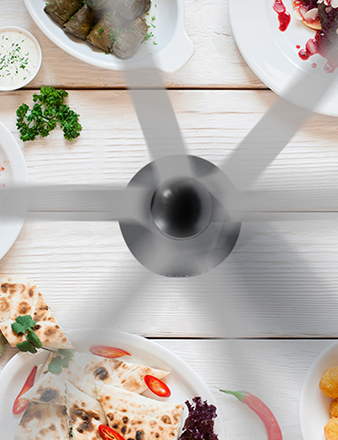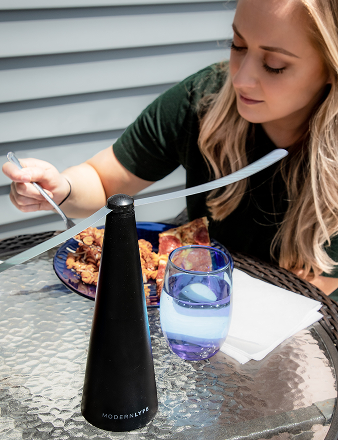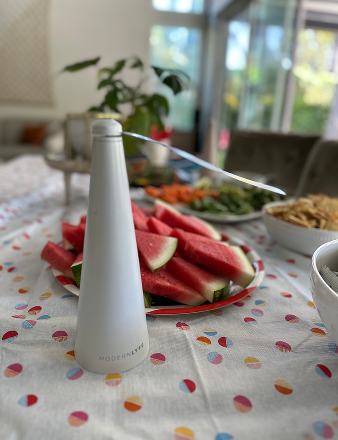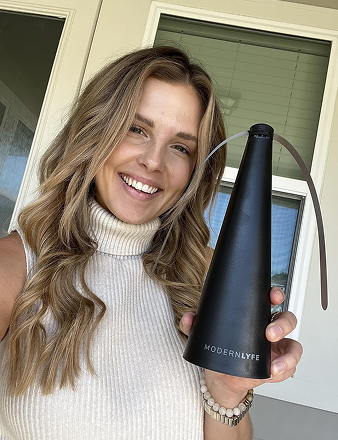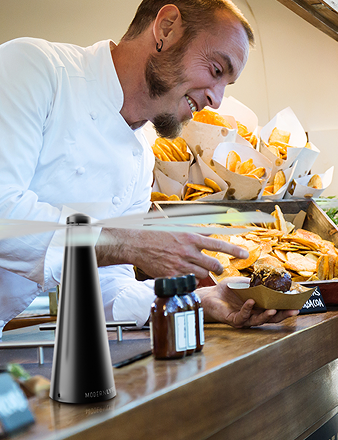An outdoor table fan is a compact, portable fan built to handle the elements. Unlike standard indoor fans, these are made with weather-resistant materials and specially rated motors that can withstand sun and moisture. They're the perfect solution for patios, decks, and outdoor dining spots.
Beat the Heat Instantly with the Right Fan
A beautiful summer day is wasted if the heat is unbearable. When your patio feels like an oven, an outdoor table fan is a smart, direct way to reclaim your space. It creates an instant, focused comfort zone, turning a sweltering spot into a personal oasis.
Think of it this way: a large misting system is like a floodlight, cooling a wide area. An outdoor table fan is a spotlight of cool air. It directs a refreshing breeze exactly where you need it, without soaking you, your furniture, or your guests.
This targeted approach offers several key benefits.
- Unmatched Portability: These fans are lightweight and compact. You can easily move one from your outdoor dining table to a lounge chair.
- Energy Efficiency: They use a fraction of the power of large pedestal fans or outdoor air conditioning units, keeping your electricity bill down.
- Targeted Airflow: The concentrated breeze provides immediate relief and is surprisingly effective at keeping bugs away from your space. You can learn more about that here: https://modernlyfe.com/blogs/articles/outdoor-fans-to-keep-bugs-away.
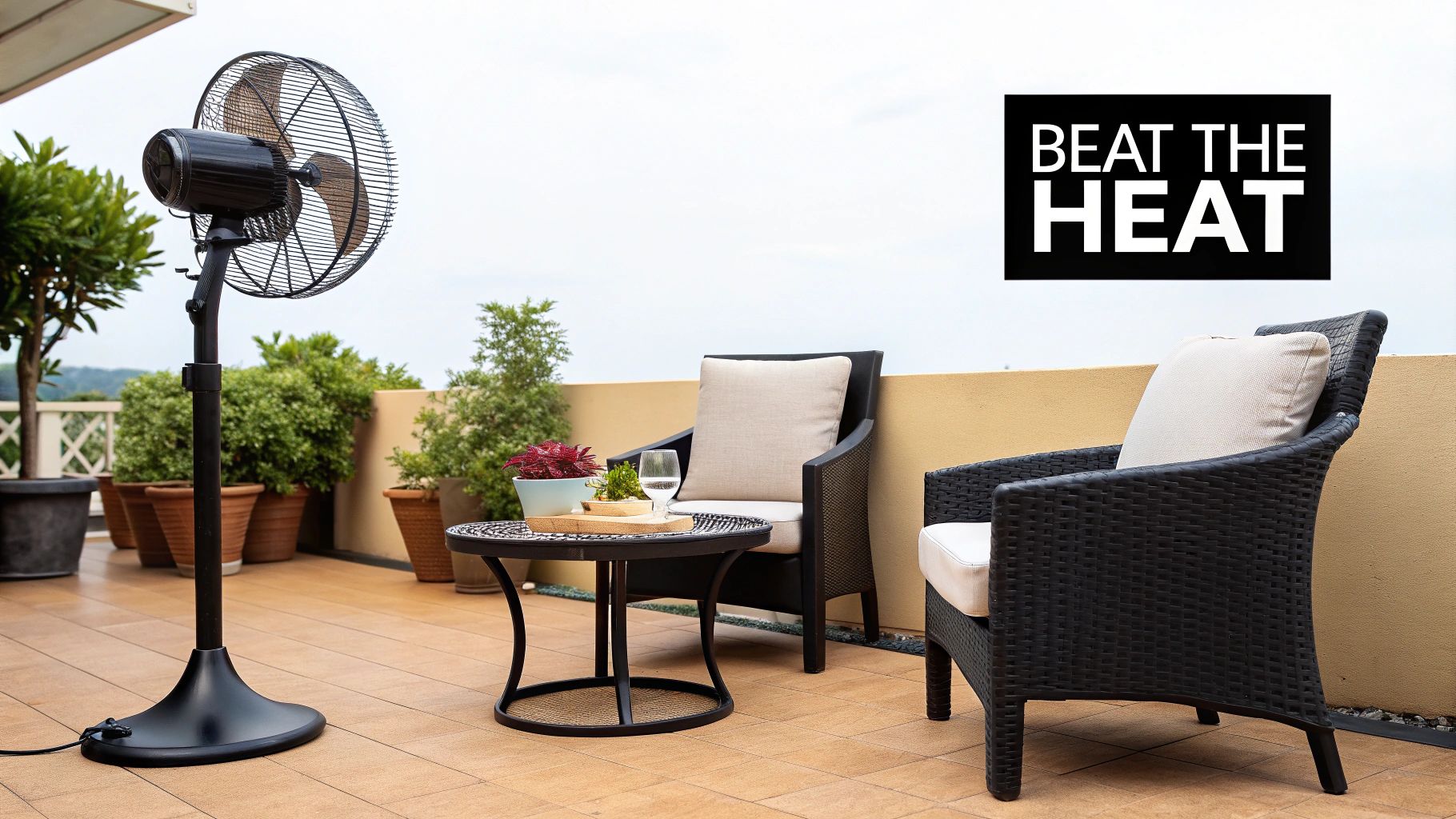
An effective outdoor table fan does more than move air; it transforms your personal space, making outdoor living pleasant even on the hottest days. It's a small investment that extends the usability of your outdoor areas all season long.
Pairing these fans with other smart techniques can make a huge difference. For more ideas on staying comfortable when temperatures soar, check out these excellent heatwave outdoor survival strategies. Knowing how to manage extreme heat is key to enjoying your summer safely.
Before diving into specific features, here’s a quick rundown of the main advantages.
Key Benefits of Outdoor Table Fans at a Glance
This table breaks down the core advantages of adding a table fan to your outdoor setup, showing how each benefit translates into a better experience.
| Benefit | What It Means for You |
|---|---|
| Instant Personal Cooling | Creates an immediate comfort zone without cooling the entire patio. |
| Excellent Portability | Easy to move and position exactly where you need a breeze. |
| High Energy Efficiency | Lowers energy consumption and costs compared to larger systems. |
| Natural Bug Repellent | The steady airflow makes it hard for mosquitoes and flies to land near you. |
| Quiet Operation | Designed to provide a cooling breeze without drowning out conversation. |
| Space-Saving Design | A compact footprint leaves plenty of room on your table. |
As you can see, these small fans deliver significant value. They offer a simple, effective, and affordable way to make your outdoor spaces more enjoyable.
How Outdoor Table Fans Are Built to Last
An outdoor table fan is engineered to be tough. While a standard indoor fan is designed for a climate-controlled environment, an outdoor fan is built to face sun, moisture, and temperature swings. This durability comes from specific choices in materials and construction.
Indoor fans often use basic plastics and untreated metals that fail outdoors. A quality outdoor table fan uses UV-stabilized plastics that won't crack or fade in the sun. Metal parts are typically powder-coated steel or aluminum, creating a durable barrier against rust and corrosion from humidity and rain.
Engineered for Safety and Performance
The internal components are what truly set them apart. The motor is the heart of the fan, and in an outdoor model, it needs to be protected. This is where safety ratings are non-negotiable.
Most reliable outdoor table fans have a UL wet or damp rating. This certification means the motor casing is sealed to keep moisture away from the electrical components, cutting the risk of short circuits. This allows you to run it safely on a muggy evening or during a light mist. If you want to ditch the cord completely, check out our guide on battery-operated table fans for excellent portable options.
This infographic highlights the key differences between a standard indoor fan and its rugged outdoor counterpart.
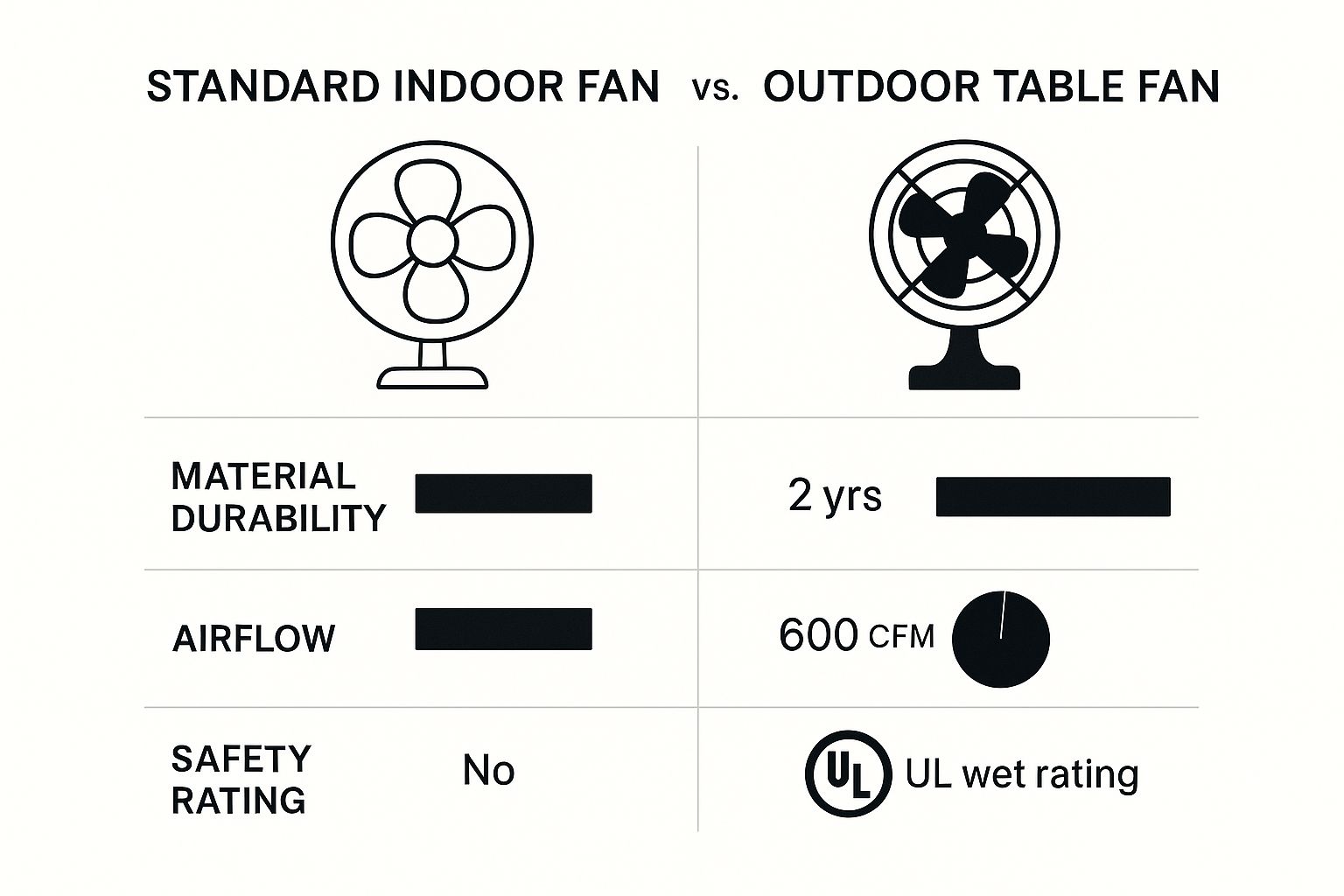
It's clear that outdoor fans aren't just tougher; they're also more powerful and certified for safety in conditions where an indoor model would be a hazard.
Understanding Airflow Power
A fan's job is to move air. This power is measured in CFM, or Cubic Feet per Minute. Think of CFM as a fan's horsepower—a higher number means it's pushing more air. A small desk fan might have a CFM of 500-600, but a proper outdoor table fan often exceeds 1,000 CFM. That extra power is needed to cut through outdoor breezes and deliver a noticeable cooling effect.
A fan with a high CFM rating doesn't just create a breeze; it creates a bubble of comfort. It's powerful enough to keep you cool and effectively deter insects like flies and mosquitoes, which are weak flyers.
This demand for durable, powerful cooling is driving the market forward. The global table fan market was recently valued at around USD 2.6 billion and is projected to keep growing, largely because people want portable, energy-efficient cooling solutions. It's clear that consumers see the value in buying a high-performance fan built for the job.
What To Look For In a Great Outdoor Fan
Not all outdoor table fans are created equal. A truly great fan combines smart design, practical features, and durability. Knowing what to look for will completely change your outdoor experience.
These features aren't just bullet points on a box; they're what make a fan genuinely useful every day. Let's get into what really matters.
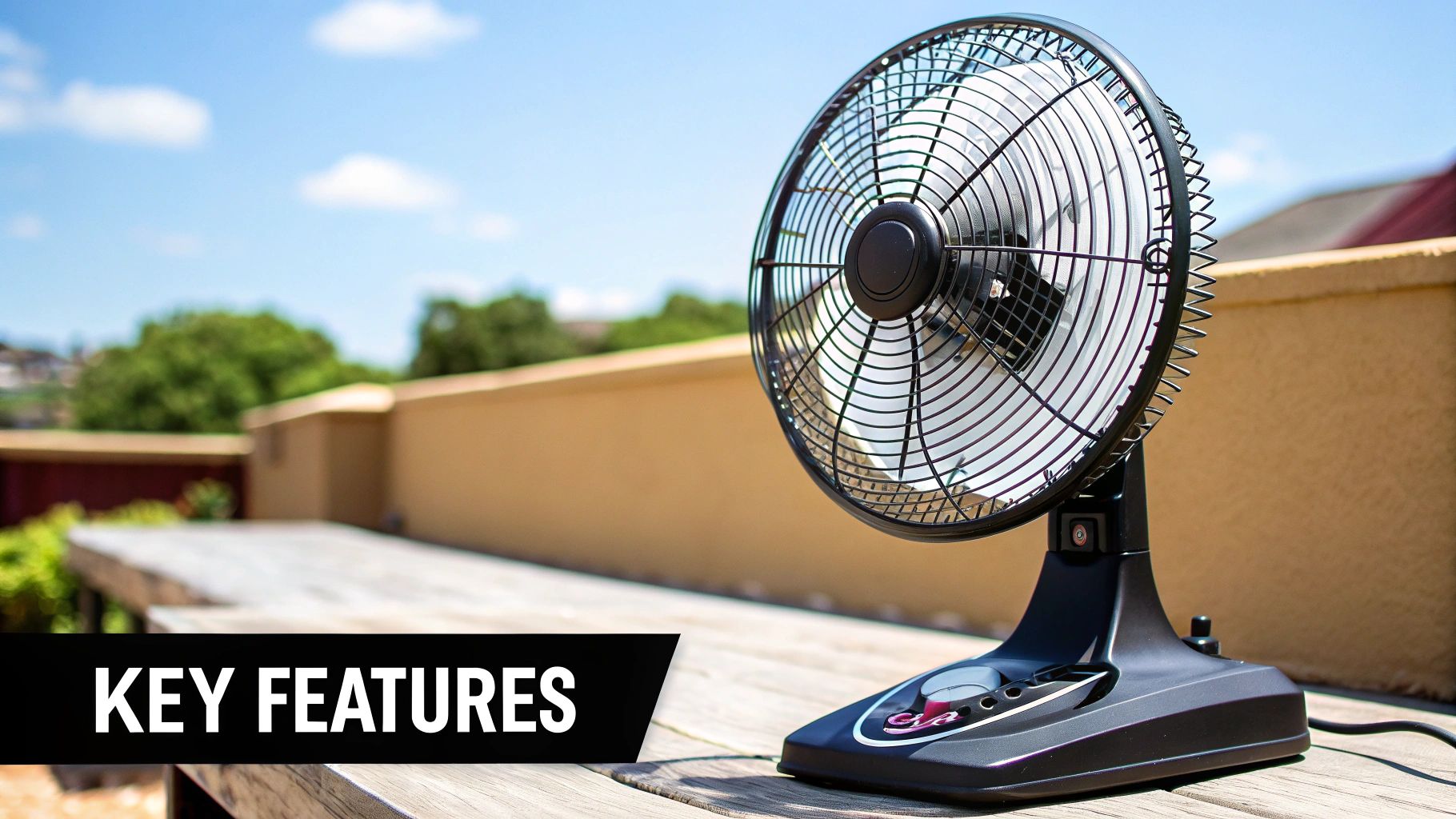
The Non-Negotiable Basics
Before considering extras, ensure the fan gets the fundamentals right. These are the core features that ensure it performs effectively and safely.
- Variable Speed Settings: You need control. Go from a quiet breeze for dinner to a full gust during midday sun. A fan with at least three speed options is the minimum standard.
- Wide Oscillation: A fan blowing in one direction only helps one person. Oscillation spreads the cool air across a whole table or seating area so everyone can enjoy the breeze.
- A Heavy, Stable Base: This is a critical safety feature. A sudden gust of wind can topple a flimsy fan. A weighted base keeps it grounded, preventing accidents.
The Big Decision: Corded vs. Battery-Powered
Your next major choice is the power source. This decision is a trade-off between consistent, raw power and ultimate portability.
Think of it like a home stereo versus a portable Bluetooth speaker. One is a powerhouse that stays put; the other goes wherever the party is.
Each has its place. Understanding the pros and cons will point you to the right fan for your needs.
Feature Comparison: Corded vs. Battery-Powered Fans
This table breaks down the key differences to help you decide which power source fits your lifestyle.
| Feature | Corded Outdoor Fans | Battery-Powered Outdoor Fans |
|---|---|---|
| Power Output | Delivers strong, consistent airflow that never fades. | Airflow can weaken as the battery drains; may be less powerful overall. |
| Portability | Tethered to an outlet, limited by cord length. | Go-anywhere freedom. Place it on a picnic blanket, a boat, or anywhere else. |
| Best For | Patios, decks, and covered outdoor dining areas with easy power access. | Camping, tailgating, events, or any spot far from an outlet. |
| Runtime | Unlimited. Runs as long as it's plugged in. | Limited by its charge, usually between 4 to 20 hours. |
Ultimately, a corded fan is a reliable workhorse for a fixed spot, while a battery-powered one is a versatile adventurer.
Valuable Extras That Elevate The Experience
Once you've covered the essentials, a few extra features can turn a good fan into a great one. You may not need all of these, but they can be a huge plus.
- Integrated Misters: A game-changer in hot, dry climates. A misting function sprays an ultra-fine veil of water that evaporates instantly, actively cooling the surrounding air.
- Built-In LED Lights: Perfect for evenings on the patio. A fan with its own light source means you don't need a separate lamp, reducing clutter and adding ambiance.
- Remote Controls: Pure convenience. A remote lets you adjust settings from across the patio without getting up. For a restaurant owner, it’s a must-have for tweaking guest comfort without being intrusive.
Choosing the Perfect Fan for Your Space
Picking the right outdoor table fan isn't about finding the "best" one—it's about finding the right one for your space. A fan that's perfect for a tiny balcony would be lost on a sprawling restaurant patio. The key is to match the fan’s capabilities to your actual needs.
First, think about where and how you’ll use it. A fan's real value is how it improves your space, whether that's turning a sweltering porch into a workspace or keeping dinner guests comfortable.
Let's walk through common scenarios to see how different needs require different fans.
Scenario 1: The Balcony Office
If you're a remote worker using a small terrace as an office, your priorities are portability and precision. You need a focused breeze that cools you without blowing your papers away.
- Ideal Fan Type: A battery-powered model is your best option. No cords, no fuss. You can place it exactly where you need it.
- Key Features: Look for a small footprint, multiple low-speed settings for gentle airflow, and a quiet motor that won't disrupt conference calls. Aim for a battery life of at least 6-8 hours to get through the workday.
Scenario 2: The Family Deck Dinner
Hosting a barbecue on the back deck? The goal is to keep everyone cool without creating a wind tunnel. You need broad coverage and a stable base.
A corded outdoor table fan with a solid CFM (Cubic Feet per Minute) rating is a great choice. It has the steady power to keep a group of four to six people comfortable all evening.
The best fan for a social gathering is one you barely notice. It should add a subtle, refreshing breeze, making the atmosphere so pleasant that your guests want to linger longer.
Combining a good fan with proper shade is also a game-changer. Solutions like Cape Town umbrella hire can work with your fan to create the ultimate cool zone.
Scenario 3: The Busy Cafe Patio
For a restaurant owner, an outdoor fan is an investment in customer experience. It must be tough, powerful, and easy for staff to operate. You're not cooling one person; you're making an entire area more inviting.
- Ideal Fan Type: Only consider models with a UL wet rating. A sturdy, corded commercial fan is essential to withstand surprise rain and the daily wear of a busy patio.
- Key Features: You'll want a high CFM for serious cooling, wide oscillation to reach multiple tables, and a heavy, tip-resistant base for safety. A remote control is a huge bonus, letting your team make adjustments without hovering over diners.
It's no surprise that demand for these cooling solutions is booming. The portable fan market was recently valued at over USD 3 billion, with homeowners leading the charge for more energy-efficient ways to beat the heat.
Keep Your Fan Running for Years with Simple Maintenance
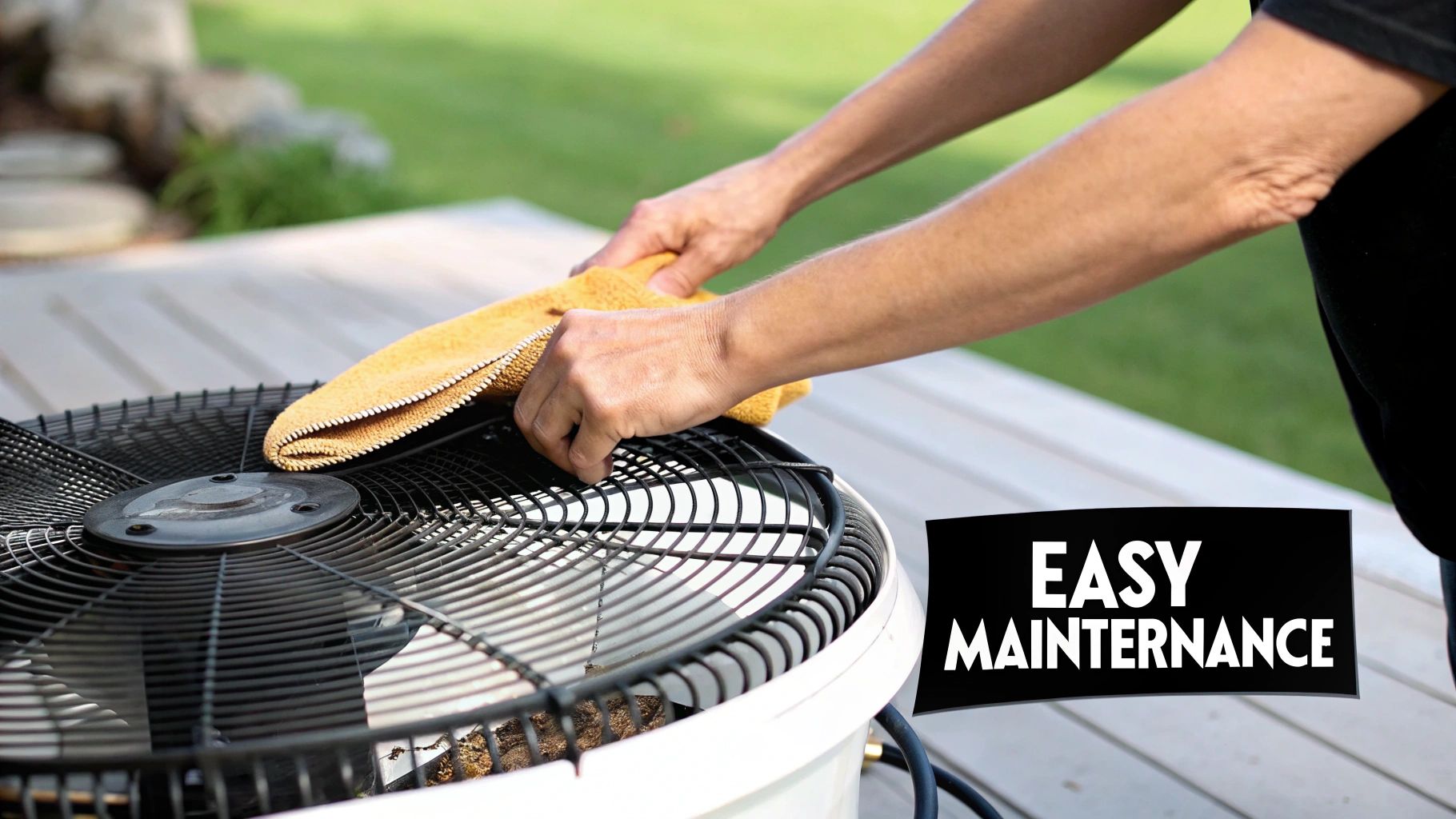
Your outdoor table fan is built to be tough, but it still battles dust, pollen, and humidity. A little regular care is the secret to protecting your investment and ensuring it keeps you cool summer after summer. Think of it like washing your car—a quick cleanup prevents long-term wear.
Good maintenance doesn't just extend the fan's lifespan; it improves performance. When fan blades get caked with dirt, the motor works harder to move air. This strain can lead to poor performance and eventually burn out the motor. A few minutes of cleaning can make a huge difference.
Routine Cleaning and Inspection
Keeping your fan in prime condition is easy. The most important rule? Always unplug the fan before you start. Safety first.
- Wipe Down the Grilles and Blades: Use a soft, damp cloth to wipe the front and back grilles. If the blades are grimy, use a little mild soap and water. Avoid harsh chemical cleaners, as they can damage the fan's protective finish.
- Inspect the Power Cord: Check the entire power cord for any cracks, frays, or damage. If you spot anything wrong, stop using the fan immediately and contact the manufacturer for repair.
- Check for Stability: Gently shake the fan. If it wobbles, tighten the screws on the base and housing. A wobbly fan is noisy and can be a tipping hazard.
This proactive care is smart for any outdoor appliance. It’s no wonder these types of fans are so popular. The global Desk Fans Market, which includes many models similar to outdoor table fans, was valued at over USD 1.6 billion. That figure shows how much people value reliable, compact cooling.
Off-Season Storage and Troubleshooting
When the weather turns cold, proper storage prevents rust and protects the motor. Before storing your fan, give it one last thorough cleaning to remove summer dust and pollen.
A dry, sheltered spot like a garage, shed, or basement is ideal. If possible, cover it with a sheet or put it back in its original box. This keeps dust from getting into the motor housing while it's stored.
A well-maintained fan is a reliable fan. Most common issues can be fixed with simple troubleshooting, saving you a call to a professional.
If your fan isn't working perfectly, try these quick fixes.
- Weak Airflow: This is usually caused by dirty blades. A simple cleaning is often all it takes to restore strong airflow.
- Strange Noises: A rattling or clicking sound is often just a loose screw or debris like a leaf stuck in the grille. Unplug the fan and take a close look. Speaking of airflow, you might find our guide on the best fly repellent fan interesting, as it explains how a steady breeze is great for keeping pests away.
Common Questions About Outdoor Fans
When considering an outdoor table fan, a few questions usually come up. Getting clear answers helps you buy with confidence.
Let's walk through some of the most common questions.
Can I Just Use My Regular Indoor Fan Outside?
This is the most popular question, and the answer is a hard no. It’s not just a bad idea—it’s a safety hazard.
Indoor fans aren't built for outdoor conditions. Their motors and wiring are exposed, and any rain, dew, or even heavy humidity could create a serious electrical risk. On top of that, the materials will break down quickly.
- UV Damage: The sun’s rays will make plastic parts brittle, causing them to crack and fade.
- Rust and Corrosion: Without weather-resistant coatings, metal components will quickly start to rust.
An outdoor fan is a completely different product, engineered for safety and durability. Always look for a fan with a UL wet or damp rating. That certification is your guarantee that it's built to handle moisture safely.
Do Outdoor Table Fans Really Keep Mosquitoes Away?
Yes, they work surprisingly well. The breeze from a good fan creates a no-fly zone for mosquitoes and other pests.
Mosquitoes are very weak flyers. A breeze of just a few miles per hour is enough to throw them off course, making it nearly impossible for them to land on you. It's like creating a protective bubble around your table.
The fan’s airflow also disperses the carbon dioxide (CO2) you exhale, which is the main signal mosquitoes use to find you. By scattering that CO2, you become much harder for them to detect. It's a fantastic, chemical-free line of defense.
What Is CFM, and How Much Do I Need?
CFM stands for Cubic Feet per Minute. It measures how much air a fan moves. Think of it like horsepower—a higher CFM means a more powerful breeze.
Matching the fan's power to your space is key. You want enough airflow to be comfortable, but not so much that you're in a wind tunnel.
- Personal Use (1-2 People): For a small balcony or next to a lounge chair, a fan with 200 to 500 CFM provides a gentle, focused breeze.
- Small Gatherings (4-6 People): To cool a patio table, look for a fan in the 500 to 1000 CFM range. That’s enough power to keep everyone comfortable.
More important than max CFM is having variable speed settings. The ability to adjust the airflow gives you total control, letting you switch from a quiet breeze to a powerful gust as needed.
Are Battery-Powered Outdoor Fans Actually Powerful Enough?
Yes. Modern battery technology has come a long way. Today’s battery-powered fans use advanced lithium-ion batteries that deliver strong, consistent airflow for hours on a single charge.
While they may not reach the same peak power as a heavy-duty corded fan, they are more than strong enough to cool you and a few friends. Their biggest advantage is portability. You can take that cool breeze to a picnic, the beach, or any spot without an outlet.
When looking at a battery model, check its CFM rating and the estimated battery life on different speed settings. That will tell you if it has the power and stamina for your needs.
Ready to find the perfect fan to keep your outdoor gatherings comfortable and fly-free? Explore the collection at MODERN LYFE and discover an elegant, effective solution for your home or business. Find your ideal fan today at https://modernlyfe.com.

